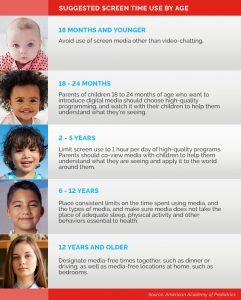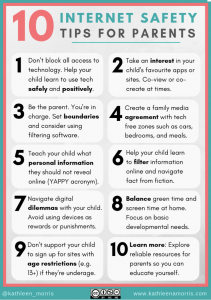9 Internet Safety and Screen Time
Kathryn Root
Introduction
Nearly half of all children eight years old and younger have their own device and spend about 2.25 hours a day on screens (Cross, n.d.). This issue grew with the shift to online school during the rise of the COVID-19 pandemic and social distancing. Many kids were in front of screens for hours, with little to no social time with others (Luijten et al., 2021). With the change to a virtual world, more children spend time with media and technology than ever before. Therefore, it’s important to know how internet and screen use can affect a child’s growth.
How Does Internet and Screen Use Affect a Child’s Health?
Screen time impacts brain and social development in children, even at an early age (Pappas, 2020). For example, children at ages 24 and 36 months who spent more time per week on screens scored lower on screening tests for levels of behavioral and social development (Pappas, 2020). Children tend to learn better from someone in-person rather than on a screen, regardless of the topic. Screen time also impacts mental and physical health, especially when watching television (TV). In fact, research shows that spending more time watching TV is linked to anxiety, lower self-esteem, and higher body mass index (Pappas, 2020). Young children who watch too much TV tend to score lower on reading tests and show attention problems (Cross, n.d.). Additionally, children have a 49% increased chance of language delay for every 30-minute increase in screen time (Mosaic Health & Rehab, 2020). Since talking face-to-face with a child is essential for language and social development, it’s key to avoid interactions through a screen (Cross, n.d.).
Blue light from screen use has a significant effect on a child’s health. It can cause damage to the eye because the lens in a child’s eye does not filter blue light as effectively as an adult’s lens (Eyesafe, 2021). It also disrupts circadian rhythm and melatonin production. Using tablets and smartphones before bed keeps the body more alert and decreases the amount of sleep a child gets (Cross, n.d.). Additional consequences include dry eyes, blurred vision, and headaches (American Optometric Association, n.d.). This being said, it is also important to note that the true long-term effects of blue light on a child’s health is not well known. Further research and studies may provide insight in the future.
How Much Screen Time Is Enough?
Setting time limits on device use can be beneficial for children. According to the World Health Organization (WHO) and the American Academy of Pediatrics (AAP), children should not have any screen time until 18 to 24 months (Pappas, 2020). They also suggest that kids ages 2-5 should spend an hour or less per day on their devices (Pappas, 2020). According to a JAMA Pediatrics (2014) study, children had improvements in sleep quality, school success, and behavior when parents limited screen use. Even older children should have limits as well. For example, Dr. Cross (n.d.) suggests that pre-teen kids have consistent limits on their screen time and the types of media they watch. Teenagers should have set times where no media should be used, such as bedtime and during dinner (Cross, n.d.). For more information on suggested screen use by age, see the graphic below.

Caregivers should also read reviews about appropriate apps, games, and videos for children to make better choices for screen time use. Since adults are the main figures that kids look to for guidance, they should monitor and limit their own device use. Adults should focus on making sure that screen time does not prevent children from getting enough sleep or physical activity (Cross, n.d.). In fact, children who spend more time on technology tend to eat more fast food and get less sleep and exercise (Cross, n.d.). This being said, it’s crucial for parents to keep a healthy balance between device use and other physical activities.
What Internet Use Rules Are Best for Children?
Criminals and predators contact children online, so every child needs to understand the dangers of giving out personal information on the Internet. They should never meet in person with anyone they meet online. Rules should be set for using internet chat rooms and social media, like keeping all accounts private. Setting parental controls on devices and moving them into a family room while using social media prevents children from visiting dangerous social websites (Child Development Institute, n.d.). Parental controls need to be made in an environment of affection and communication in order to be effective. Forcing restrictions without an explanation causes conflict and makes family unity harder for parents and children (Alvarez-Garcia et al., 2019). Therefore, parenting styles play a role in how well a child responds to limits on screen time and the Internet.
If a child does not follow the rules, it’s crucial to restate them and make the punishments known. However, in situations where a child is talking to online strangers, it may be vital to ban them from using the internet or blocking the websites they visit (Child Development Institute, n.d.). This will send the biggest message and may restore control over the child again (Child Development Institute, n.d.). More internet safety tips for parents and caregivers is linked here. The graphic below lists ten tips for parents to use when addressing internet safety.

Resources
The Internet allows for open access to information at any time, but it can also bring new cyber threats to children. According to the Readiness and Emergency Management For Schools Technical Assistance Center (n.d.), there are many resources available for parents and children to be educated about online safety.
- STOP.THINK.CONNECT
- STOP.THINK.CONNECT is a national effort to provide education on cyber threats using videos and blogs.
- OnGuard Online
- OnGuard Online is a resource for teachers and caregivers to learn how to talk to their children about internet safety.
- NetSmartz Workshop Online Program
- The NetSmartz Workshop Online Program provides information to caregivers on how they can teach children to recognize internet threats, cyberbullying, and how to be safer online.
- Children’s Internet Protection Act (CIPA)
- CIPA protects children from harmful content on the internet and gives schools a discount for web access through the E-rate program.
Key Takeaways
- Since children use the Internet and devices more than ever before, it’s vital for caregivers to know how it impacts health and growth.
- Too much screen time affects a child’s health from an early age and can lead to anxiety, language delay, poor test scores, and eye damage.
- Limiting screen time can be very beneficial for children and varies based on age. Caregivers should model proper screen use and maintain a balance between device time and other activities.
- Caregivers should educate their children about the dangers of talking to strangers online, monitor their child’s activity on the Internet, and set parental controls.
- There are many resources available for caregivers to learn more about screen use and internet safety.
References
Álvarez-García, D., Núñez, J. C., González-Castro, P., Rodríguez, C., & Cerezo, R. (2019). The effect of parental control on cyber-victimization in adolescence: The mediating role of impulsivity and high-risk behaviors. Frontiers in Psychology, 10, 1159. doi: 10.3389/fpsyg.2019.01159
American Optometric Association. (n.d.) Blue light impact in children. https://www.aoa.org/AOA/Documents/About%20the%20AOA/Get%20Involved/Blue%20Light%20Impact%20in%20Children.pdf
Child Development Institute. (n.d.) Internet safety for kids and teens. https://childdevelopmentinfo.com/family-living/kids-media-safety/children-teens-web-internet-safety/#gs.nmkhzc
Cross, J.F. (n.d.) What does too much screen time do to children’s brains? Health Matters. https://healthmatters.nyp.org/what-does-too-much-screen-time-do-to-childrens-brains/
Eyesafe. (2021, June 29). Children and high-energy blue light: A cause for concern. https://eyesafe.com/children-and-high-energy-blue-light-a-cause-for-concern/
Gentile, D. A., Reimer, R. A., Nathanson, A. I., Walsh, D. A. & Eisenmann, J. C. (2014). Protective effects of parental monitoring of children’s media use. JAMA Pediatrics, 168(5), 479-484. doi:10.1001/jamapediatrics.2014.146
Luijten, M.A., van Muilekom, M.M., Teela, L., Polderman, T.J.C., Terwee, C.B., Zijlmans, J., Klaufus, L., Popma, A., Oostrom, K.J., van Oers, H.A. & Haverman, L. (2021, May 15). The impact of lockdown during COVID-19 pandemic on mental and social health of children and adolescents. Quality of Life Research, 30, 2795-2804. https://doi.org/10.1007/s11136-021-02861-x
Mosaic Health & Rehab. (2020, August 31). Effects of screen time on language development of young children. https://mosaicrehabmt.com/effects-of-screen-time-on-language-development-of-young-children/#:~:text=For%20every%2030%20minute%20increase,developing%20language%20and%20literacy%20skills.
Pappas, S. (2020). What do we really know about kids and screens? Monitor on Psychology, 51(3), 42. https://www.apa.org/monitor/2020/04/cover-kids-screens
Readiness and Emergency Management For Schools (REMS) Technical Assistance (TA) Center. (n.d.). Cyber Safety Considerations for K-12 Schools and School Districts. https://rems.ed.gov/docs/Cyber_Safety_K-12_Fact_Sheet_508C.pdf
a measure of body fat that is the ratio of the weight of the body in kilograms to the square of its height in meters
a color in the visible light spectrum that can be seen by human eyes
a round body in the eye that focuses light rays on the retina
being, having, characterized by, or occurring in approximately 24-hour periods or cycles
a hormone secreted by the pineal gland, especially in response to darkness, and has been linked to the regulation of circadian rhythms

